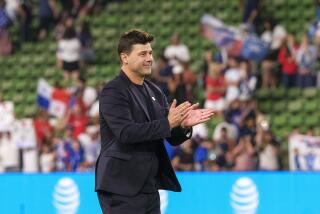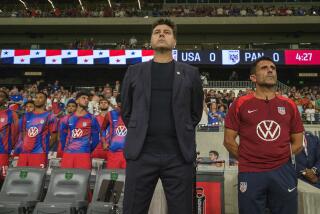WORLD CUP USA 1994 : High-Tech Ally Aids U.S. Soccer Team : Strategy: Analysts will use a revolutionary computer program to analyze Brazilian squad in today’s second-round matchup.
- Share via
The U.S. soccer team, a mere infant when compared to some of the giants in the world’s most popular sport, is using its prowess in the technological world to attempt to gain an advantage over its opponents in the World Cup.
The team will use its new tool, a computer program stored in floppy discs, against the powerful Brazilian team when they meet today in the Cup’s second round in Palo Alto.
The program analyzes every movement of the ball on the field, and coaches will use the program to plot a strategy against opposing teams, take advantage of an opponent’s weaknesses and defend against its offensive strengths.
“In my opinion, it’s a revolutionary form of analysis,” said Steve Sampson, the assistant coach of the U.S. team. “To my knowledge, it’s never been used in any sport.”
The program, used in the impressive victory over Colombia, was created by two San Fernando Valley engineers and interpreted by Sampson, 37, a former UCLA and University of Santa Clara soccer coach from Agoura Hills.
Zvi Friedman, 59, a systems analyst and lifelong soccer enthusiast, and Jon Kotas, a co-worker and computer expert, crafted a program that allows them to track every movement of the ball in a soccer match.
With a pair of binoculars, a computer keyboard and mouse, and their patented computer code called Scribbler, Kotas and Friedman can sit in the stands or press box and enter data that later will be printed out on a chart showing who passed the ball to whom, how often, which passes were completed and where on the field a player makes his passes or scoring attempts.
A coach such as Sampson can then study the information, print out a booklet that is distributed to the players, and then plan how a particular opponent tends to attack or defend. Combined with a videotape of the same match, the information comes alive, Sampson said.
“Players can look at the information on the bus, on the plane, at the training center,” Sampson said. “You start to see patterns in the way a team plays, to see such things as who a player tends to give the ball to. If we can give our players any kind of competitive edge, that’s what they really ask of us.”
For players such as starting defender Paul Caligiuri, 30, a native of Westminster now living in Diamond Bar, the new computer analysis is a major advance.
“It’s a tremendous addition to our operation, I think,” Caligiuri said last week after practice at the Mission Viejo training center. “This is the first time I’ve used it and it’s helped me a lot. . . . Basically, I tend to do certain things on the field and if something I want didn’t happen, I can see why.”
Other national teams such as Germany’s have started using a computer, but nothing as sophisticated as the program designed by Kotas and Friedman, Sampson said. Many purists, such as Coach Bora Milutinovic of the U.S. team, do not put much credence in the technology, Sampson said.
“A lot of traditionalists resent it,” Sampson said. “Bora himself has been very difficult to warm up to this, but a lot of it is that he’s not comfortable with the computer.”
Sampson predicts that the use of the computer will evolve like the use of videotape did. “Now it’s practically impossible to prepare a team without videotape,” he said.
The computer program offers more than preparation.
It can be used to make quick adjustments during a game--witness the U.S. team’s 2-1 victory over Colombia on June 22, a victory that some consider the greatest upset in World Cup history.
At halftime of that match, Friedman, clutching a few charts taken from the first half, sprinted from the Rose Bowl press box through rows of fans to deliver some critical information to Sampson.
The charts showed that Colombia’s Wilson Perez was attacking constantly on the right side of the field and not coming back to defend. The charts also showed that the United States was attacking almost entirely from the left side, the opposite side that Perez was leaving unguarded.
In the second half, Ernie Stewart scored to give the U.S. a 2-0 lead. The ball came down the right side of the field.
On defense, the U.S. team tracked the tendencies of the Colombian attackers.
“We knew going into the game where they were likely to handle the ball,” Caligiuri said. “We knew they didn’t attack down the wings and that allowed us to concentrate on funneling them down the middle.”
Added Sampson: “Their shots on goal mostly came from a central position, which is exactly what we wanted.”
The system’s most important test will come today at Stanford Stadium when the U.S. team plays one of the favorites to take the cup, mighty Brazil.
Sampson and Milutinovic have pored over the charts provided by the system, but Brazil plays with a unique style.
“The computer has provided us some detailed information, but each game is different, especially when you play a team like Brazil,” Milutinovic said Thursday at the training camp. “Brazil is a team that bases its game on improvisation, using players who are the best in the world.”
The Brazilians also happen to be the other national team involved with Kotas and Friedman. After seeing a presentation of the program in January, Brazilian Coach Carlos Alberto Parreira bought the services of Kotas and Friedman (they provide the program free to the U.S. team).
By contractual arrangement, however, Kotas and Friedman will not provide Brazil any information on the U.S. during or before the match. If Brazil wins, Kotas and Friedman will again work with that team.
After studying stacks of notes on Brazil, Friedman has become a believer in the genius of their players.
“If anybody is going to win the World Cup, it should be Brazil with their great talent,” he said. “But, maybe, hopefully, the U.S. can pull off the upset of the century. . . . We’re going to the quarterfinals either way.”






